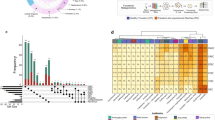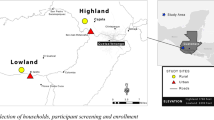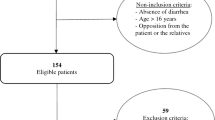Abstract
The use of preventive measures and self-treatment for travelers' diarrhea is routine in regions where the occurrence of diarrhea is predictably high. People traveling to these areas who do not exercise care in their selection of consumed foods and beverages will suffer high rates of illness. Such diarrhea normally affects the traveler for a day, although it can result in chronic postinfectious irritable bowel syndrome. Although systemic antibacterial drugs are effective in preventing diarrhea, their use is not routinely recommended because of side effects and their importance as a therapy for extra-intestinal infections. This review focuses on current and future uses of antibacterial drugs in the prevention and therapy of travelers' diarrhea. Minimally absorbed (<0.4%) rifaximin can effectively reduce the occurrence of travelers' diarrhea without side effects. Bismuth subsalicylate is a useful alternative, although it is less effective than rifaximin for the prevention of travelers' diarrhea and the required doses are less convenient. All people who travel to high-risk areas should take curative antimicrobial agents with them for self-treatment of illness: rifaximin 200 mg three times a day for 3 days, or an absorbable agent such as a fluoroquinolone or azithromycin taken in a single dose initially, with the need for a second or third dose determined by clinical response. Loperamide (up to 8 mg per day for ≤2 days) can be given with the antibiotic to offer rapid symptomatic improvement. In the future, the ability to evaluate the genetic risk of illness acquisition might allow person-specific recommendations to be made.
This is a preview of subscription content, access via your institution
Access options
Subscribe to this journal
Receive 12 print issues and online access
$209.00 per year
only $17.42 per issue
Buy this article
- Purchase on Springer Link
- Instant access to full article PDF
Prices may be subject to local taxes which are calculated during checkout

Similar content being viewed by others
References
Kean BH, Waters SR (1959) The diarrhea of travelers. III. Drug prophylaxis in Mexico. N Engl J Med 261: 71–74
Ericsson CD et al. (1983) Bicozamycin, a poorly absorbable antibiotic, effectively treats travelers' diarrhea. Ann Intern Med 98: 20–25
DuPont HL et al. (1982) Treatment of travelers' diarrhea with trimethoprim/sulfamethoxazole and with trimethoprim alone. N Engl J Med 307: 841–844
Jiang ZD et al. (2002) Prevalence of enteric pathogens among international travelers with diarrhea acquired in Kenya (Mombasa), India (Goa), or Jamaica (Montego Bay). J Infect Dis 185: 497–502
Hoge CW et al. (1998) Trends in antibiotic resistance among diarrheal pathogens isolated in Thailand over 15 years. Clin Infect Dis 26: 341–345
Caeiro JP et al. (1999) Improved detection of enterotoxigenic Escherichia coli among patients with travelers' diarrhea, by use of the polymerase chain reaction technique. J Infect Dis 180: 2053–2055
Scott DA et al. (1990) Norfloxacin for the prophylaxis of travelers' diarrhea in U.S. military personnel. Am J Trop Med Hyg 42: 160–164
DuPont HL et al. (1992) Five versus three days of ofloxacin therapy for traveler's diarrhea: a placebo-controlled study. Antimicrob Agents Chemother 36: 87–91
DuPont HL et al. (1992) Oral aztreonam, a poorly absorbed yet effective therapy for bacterial diarrhea in US travelers to Mexico. JAMA 267: 1932–1935
Mattila L (1994) Clinical features and duration of traveler's diarrhea in relation to its etiology. Clin Infect Dis 19: 728–734
Haberberger RL Jr et al. (1991) Travelers' diarrhea among United States military personnel during joint American-Egyptian armed forces exercises in Cairo, Egypt. Mil Med 156: 27–30
Ericsson CD et al. (1987) Clinical presentation as a guide to therapy for travelers' diarrhea. Am J Med Sci 294: 91–96
von Sonnenburg F et al. (2000) Risk and aetiology of diarrhoea at various tourist destinations. Lancet 356: 133–134
DuPont HL and Capsuto EG (1996) Persistent diarrhea in travelers. Clin Infect Dis 22: 124–128
Okhuysen PC et al. (2004) Post-diarrhea chronic intestinal symptoms and irritable bowel syndrome in North American travelers to Mexico. Am J Gastroenterol 99: 1774–1778
Kozicki M et al. (1985) 'Boil it, cook it, peel it or forget it': does this rule prevent travellers' diarrhoea? Int J Epidemiol 14: 169–172
DuPont HL and Steffen R (Eds; 2001) Textbook of Travel Medicine and Health. Second Edition Hamilton: B.C. Decker, Inc
DuPont HL and Ericsson CD (1993) Prevention and treatment of traveler's diarrhea. N Engl J Med 328: 1821–1827.
DuPont HL et al. (1987) Prevention of travelers' diarrhea by the tablet formulation of bismuth subsalicylate. JAMA 257: 1347–1350
Hilton E et al. (1997) Efficacy of Lactobacillus GG as a Diarrheal Preventive in Travelers. J Travel Med 4: 41–43
Gorbach SL et al. (1975) Travelers' diarrhea and toxigenic Escherichia coli. N Engl J Med 292: 933–936
Sack DA et al. (1978) Prophylactic doxycycline for travelers' diarrhea. Results of a prospective double-blind study of Peace Corps volunteers in Kenya. N Engl J Med 298: 758–763
DuPont HL et al. (1983) Prevention of travelers' diarrhea with trimethoprim-sulfamethoxazole and trimethoprim alone. Gastroenterology 84: 75–80
Gomi H et al. (2001) In vitro antimicrobial susceptibility testing of bacterial enteropathogens causing traveler's diarrhea in four geographic regions. Antimicrob Agents Chemother 45: 212–216
Wistrom J et al. (1987) Norfloxacin versus placebo for prophylaxis against travellers' diarrhoea. J Antimicrob Chemother 20: 563–574
Rademaker CM et al. (1989) Results of a double-blind placebo-controlled study using ciprofloxacin for prevention of travelers' diarrhea. Eur J Clin Microbiol Infect Dis 8: 690–694
Johnson PC et al. (1986) Lack of emergence of resistant fecal flora during successful prophylaxis of traveler's diarrhea with norfloxacin. Antimicrob Agents Chemother 30: 671–674
Gorbach S and Edelman R (Eds; 1986) Travelers' diarrhea: National Institutes of Health Consensus Development Conference Bethesda, Maryland, January 28–30, 1985. Rev Infect Dis 8 (Suppl 2): S109–S233
Farthing MJG et al. (1992) Treatment and prevention of travellers' diarrhoea. Gastroenterology International 5: 162–175
Ericsson CD et al. (1985) Efficacy of bicozamycin in preventing traveler's diarrhea. Gastroenterology 88: 473–477
DuPont H et al.: Randomized placebo controlled trial of rifaximin prevention of travelers' diarrhea in Mexico where diarrheagenic E. coli are major causes of illness. Ann Intern Med, in press
Taylor D et al. (2004) Double-blind, placebo-controlled trial to evaluate the use of rifaximin (200 mg TID) to prevent diarrhea in volunteers challenged with Shigella flexneri 2a (2457T). Amer Soc Trop Med Hyg, Miami, Poster number 2079
Reves RR et al. (1988) A cost-effectiveness comparison of the use of antimicrobial agents for treatment or prophylaxis of travelers' diarrhea. Arch Intern Med 148: 2421–2427
Banwell JG (1986) Treatment of travelers' diarrhea: fluid and dietary management. Rev Infect Dis 8 (Suppl 2): S182–S187
DuPont HL et al. (1992) Evaluation of new anti-infective drugs for the treatment of acute infectious diarrhea. Infectious Diseases Society of America and the Food and Drug Administration. Clin Infect Dis 15 (Suppl 1): S228–S235
DuPont HL et al. (2001) Rifaximin versus ciprofloxacin for the treatment of traveler's diarrhea: a randomized, double-blind clinical trial. Clin Infect Dis 33: 1807–1815
Steffen R et al. (2003) Therapy of travelers' diarrhea with rifaximin on various continents. Am J Gastroenterol 98: 1073–1078
Jiang ZD et al. (2000) In vitro activity and fecal concentration of rifaximin after oral administration. Antimicrob Agents Chemother 44: 2205–2206
Vila J et al. (2000) Quinolone resistance in enterotoxigenic Escherichia coli causing diarrhea in travelers to India in comparison with other geographical areas. Antimicrob Agents Chemother 44: 1731–1733
DuPont HL et al.: Rifaximin prevention of travelers' diarrhea in Mexico. A randomized placebo controlled trial. Ann Intern Med, in press
DuPont HL and Jiang ZD (2004) Influence of rifaximin treatment on the susceptibility of intestinal Gram-negative flora and enterococci. Clin Microbiol Infect 10: 1009–1011
Krausse R and Ullmann U (2003) In vitro activities of new fluoroquinolones against Campylobacter jejuni and Campylobacter coli isolates obtained from humans in 1980 to 1982 and 1997 to 2001. Antimicrob Agents Chemother 47: 2946–2950
Ericsson CD et al. (2001) Optimal dosing of ofloxacin with loperamide in the treatment of non-dysenteric travelers' diarrhea. J Travel Med 8: 207–209
Ashley DV et al. (2004) Interventions to prevent and control food-borne diseases associated with a reduction in traveler's diarrhea in tourists to Jamaica. J Travel Med 11: 364–367
Jiang ZD et al. (2003) Genetic susceptibility to enteroaggregative Escherichia coli diarrhea: polymorphism in the interleukin-8 promotor region. J Infect Dis 188: 506–511
Ericsson CD et al. (1987) Ciprofloxacin or trimethoprim-sulfamethoxazole as initial therapy for travelers' diarrhea. A placebo-controlled, randomized trial. Ann Intern Med 106: 216–220
Wistrom J et al. (1989) Short-term self-treatment of travellers' diarrhoea with norfloxacin: a placebo-controlled study. J Antimicrob Chemother 23: 905–913
Mattila L et al. (1993) Short-term treatment of traveler's diarrhea with norfloxacin: a double-blind, placebo-controlled study during two seasons. Clin Infect Dis 17: 779–782
Salam I et al. (1994) Randomised trial of single-dose ciprofloxacin for travellers' diarrhoea. Lancet 344: 1537–1539
Adachi JA et al. (2003) Azithromycin found to be comparable to levofloxacin for the treatment of US travelers with acute diarrhea acquired in Mexico. Clin Infect Dis 37: 1165–1171
Acknowledgements
The travelers' diarrhea studies by the author that are reported herein have been supported by active grants from, among others, the US Public Health Service, which funds the Texas Gulf Coast Digestive Diseases Center, the National Institutes of Allergy and Infectious Diseases, and the Clinical Research Center, which funds the University of Texas General Clinical Research Center.
Author information
Authors and Affiliations
Corresponding author
Ethics declarations
Competing interests
The author would like to acknowledge that over the last 30 years he has received a consultant fee, honoraria for speaking and research grants to his institution from various pharmaceutical companies: A.H. Robins Company; Alfa Wassermann SpA; Bristol-Myers Squibb; Burroughs Wellcome Company; Ciba-Geigy Ltd; Hoffmann-LaRoche Inc; Janssen Pharmaceutica; McNeil Consumer Products; Merck Sharp and Dohme; Merrell Dow Pharmaceuticals Inc; Norwich Pharmacal Company and Norwich-Eaton Pharmaceuticals; Ortho Pharmaceuticals; Otsuka Pharmaceuticals; Procter & Gamble Company; Romark Laboratories; Shaman Pharmaceuticals Inc; Salix Pharmaceuticals (the manufacturer of rifaximin); SmithKline Beecham Biologicals; Upjohn Company; and Zyma SA.
Glossary
- POSTINFECTIOUS IRRITABLE BOWEL SYNDROME (IBS)
-
A common, chronic illness causing abdominal bloating with diarrhea and/or constipation following an initial bout of infectious diarrhea
- PROBIOTICS
-
Live bacteria that can be taken orally, potentially providing protection against subsequently ingested pathogens
- DOXYCYCLINE
-
An oral tetracycline antibacterial drug
- TRIMETHOPRIM-SULFAMETHOXAZOLE
-
A combination antimicrobial drug currently not recommended for the treatment of travel diarrhea because of high rates of resistance worldwide
- FLUOROQUINOLONES
-
Considered by many the optimal drugs for therapy and prevention of travelers' diarrhea; antibacterial resistance to ciprofloxacin is, however, high
- WATERY DIARRHEA SYNDROME
-
Liquid stools that are commonly passed by patients with travelers' diarrhea, particularly in cases caused by diarrheogenic E. coli
Rights and permissions
About this article
Cite this article
DuPont, H. Travelers' diarrhea: antimicrobial therapy and chemoprevention. Nat Rev Gastroenterol Hepatol 2, 191–198 (2005). https://doi.org/10.1038/ncpgasthep0142
Received:
Accepted:
Issue Date:
DOI: https://doi.org/10.1038/ncpgasthep0142
This article is cited by
-
Antibiotic resistance in Campylobacter and other diarrheal pathogens isolated from US military personnel deployed to Thailand in 2002–2004: a case–control study
Tropical Diseases, Travel Medicine and Vaccines (2017)
-
Treatment of Traveler’s Diarrhea
Current Treatment Options in Infectious Diseases (2014)
-
Ashes to ashes
Nature Reviews Gastroenterology & Hepatology (2010)



